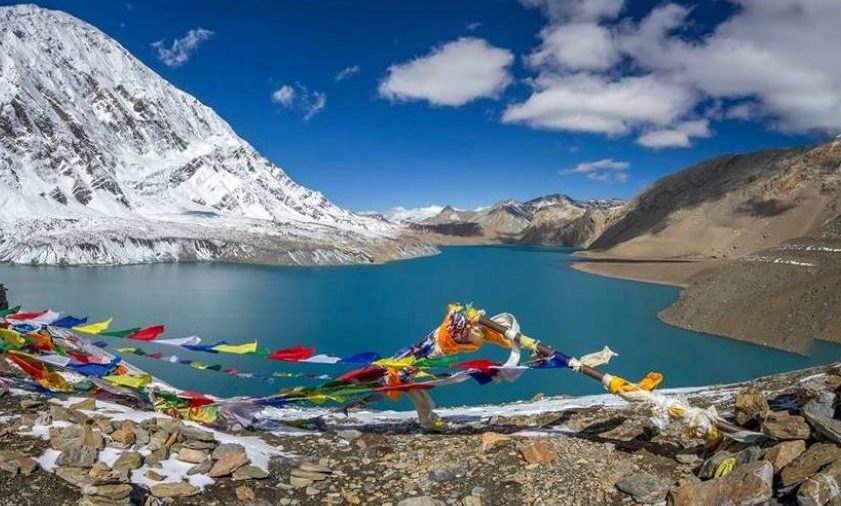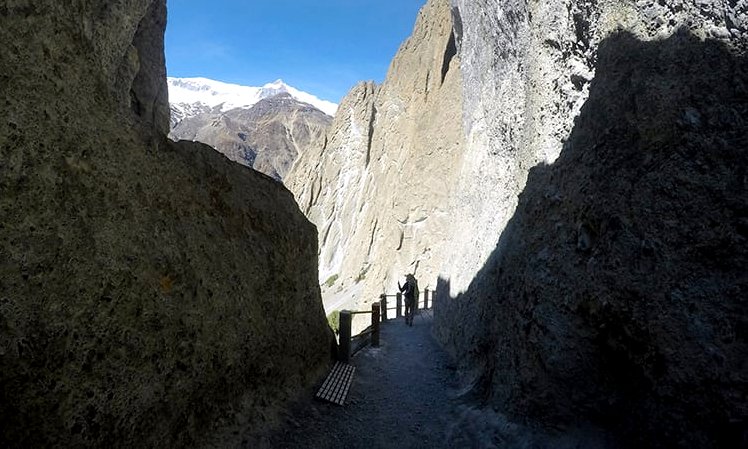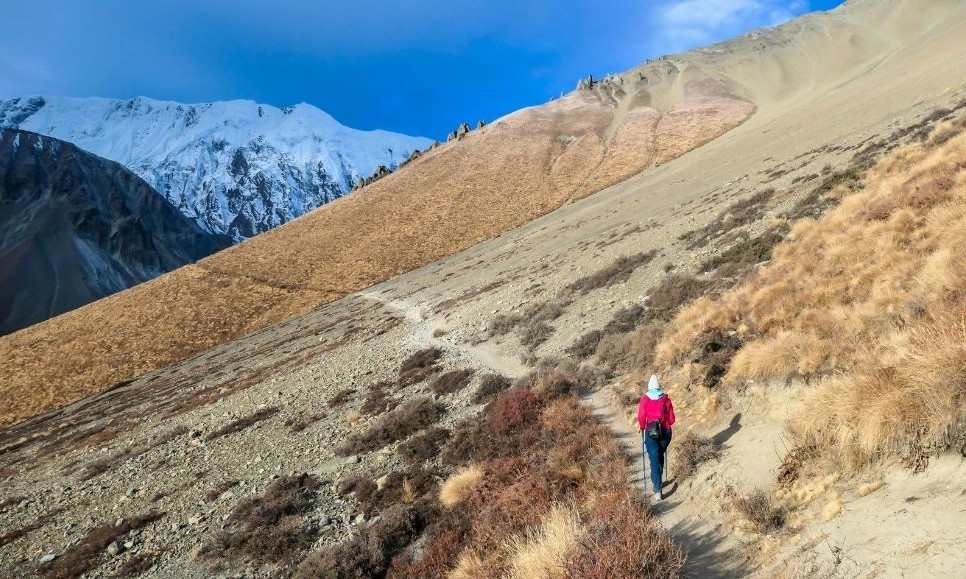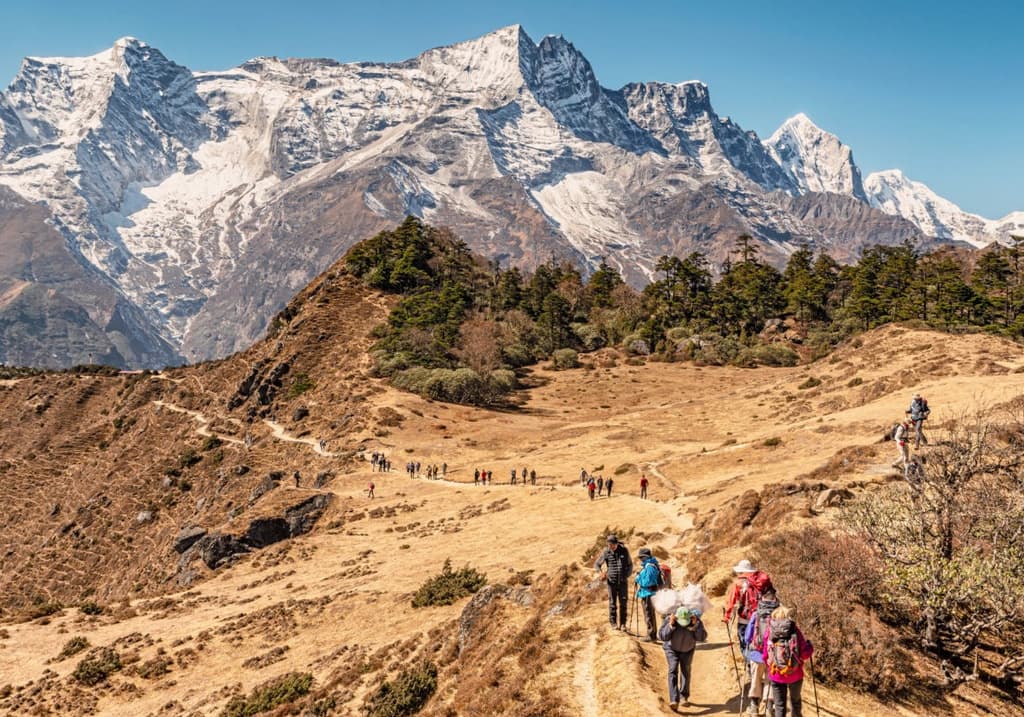Tilicho Lake Trek
The Annapurna Region stands as a pinnacle in the world of trekking, boasting some of the globe's most renowned trails such as the Annapurna Circuit Trek, Annapurna Base Camp Trek, Mardi Himal Trek, and of course, the Tilicho Lake Trek. These trails offer a uniquely diverse blend of landscapes, cultures, and mountain vistas unparalleled by other routes.
Perched at an impressive 4,919 meters above sea level, Tilicho Lake holds the title of the world's highest-altitude lake. Spanning 4 km in length, 1.2 km in width, with a depth of 85 km, it covers a surface area of 4.8 km^2. The lake nestles in the northern region of the Manang district, cradled by the majestic Annapurna Range. Fed by the melting glaciers from the northern side of the Annapurna Mountain and Thorung Peak, the vibrant turquoise waters of Tilicho Lake shine as the Himalayan jewel. This mesmerizing destination is a popular detour for those embarking on the Annapurna Circuit, one of the most celebrated trekking paths worldwide. The journey, though challenging, offers an array of experiences, from the hustle of Kathmandu to the serene beauty of Tilicho.

Tilicho Lake Trekking is an exquisite adventure in the Annapurna Region, taking trekkers through iconic destinations. Its main allure is the path leading to Tilicho Lake, the world's highest lake. This trek showcases a rich tapestry of cultures, breathtaking valleys, and the snow-capped peaks of the mighty Annapurna Family. Along the way, trekkers traverse verdant hills, sprawling meadows, traditional villages, and witness traces of Buddhist correspondence, cascading waterfalls, and adventurous terrains.
Embarking on the Tilicho Lake trek transports you to the Trans Himalayan region of Nepal. While the trek is not overly strenuous, challenges like dry landslides, falling stones, and unpredictable weather conditions add an element of thrill. It's a journey rich in cultural immersion, where you'll encounter diverse communities such as the Chhetri, Brahmin, Tibetan Sherpa, Gurung, Thakali, and Magar ethnic groups. As a bonus, this trek presents jaw-dropping views of iconic peaks like Mt. Manaslu, Lamjung Himal, Annapurna II, Annapurna III, Tilicho Peak, Gangapurna, Pisang Peak, Himal Chuli, and several other majestic mountains.
How to reach Tilicho Lake
Tilicho Lake, one of the world's highest lakes, is a pristine beauty nestled amidst the grandeur of the Himalayas. While its isolation only adds to its allure, getting there requires a bit of planning and effort. There isn't a direct roadway leading to it, but several routes can get you close. Here's a detailed guide on how to reach this breathtaking destination:

Route 1: Via Manang Valley
-
Starting Point: Pisang.
-
Day 1: Drive to Pisang and then trek to Manang.
-
Day 2: Ascend from Manang to Shree Kharka.
-
Day 3: Trek from Shree Kharka to Tilicho Base Camp. From here, it's a 5-hour trek to reach the lake. In total, it's a 3-day journey on foot starting from Pisang.
Note: If you want to shorten the walking duration, you can hire a jeep to Chame and begin your trek to Manang from there. This will take you one day of trekking to reach the Tilicho Base Camp.
Route 2: The Quick Path
- Starting Point: Shree Kharka.
- Day 1: Take a private bus to Shree Kharka.
- Day 2: Proceed directly to Tilicho Base Camp.
- Day 3: Relax and take in the breathtaking views from a motel right at Tilicho Lake.
Route 3: The Adventurous Northern Route
-
Starting Point: Jomsom and Thani Goan.
-
This challenging route involves crossing the Tilicho North pass, famously known as the Tourist pass, and moving through MesoKanto La. Unlike the southern routes which have convenient tea houses, the northern path requires a more rugged approach.
Note: Accommodation is scarce, with only two hotels situated between Thani Gaon and Tilicho Base Camp. Prepare to camp out for approximately two nights if you take this route.
The Luxurious Alternative: For those seeking comfort or running short on time, consider chartering a helicopter directly to Tilicho. While it's a pricier option, flying amidst the peaks offers an unparalleled, memorable experience, making the journey as majestic as the destination itself.
Whichever route you choose, reaching Tilicho Lake promises an adventure of a lifetime, with memories etched in your heart forever.
Major Highlights of the Tilicho Lake Trek
Here are the highlights of the Tilicho Lake Trek
- Tilicho Lake: One of the highest lakes in the world, known for its turquoise waters and breathtaking setting.
- Scenic Mountain Views: Panoramic vistas of the Annapurna and Dhaulagiri mountain ranges, including peaks like Annapurna II, III, IV, Gangapurna, and Tilicho Peak.
- Thorong La Pass: A challenging and rewarding option to extend the trek, offering stunning views and a sense of achievement.
- Manang Village: A picturesque village rich in culture, allowing you to explore monasteries and interact with the friendly locals.
- Annapurna Conservation Area: Trekking through a protected area renowned for its biodiversity, forests, rivers, and wildlife.
- Serene Landscapes: Varied terrain with terraced fields, alpine meadows, dense forests, and glacial valleys.
- Cultural Immersion: Experiencing the unique traditions, architecture, and cuisine of diverse ethnic communities like Gurungs, Thakalis, and Manangis.
- Teahouse Experience: Enjoy comfortable accommodation and meals in teahouses along the route, fostering connections with fellow trekkers and locals.
These highlights combine to make the Tilicho Lake Trek a memorable adventure encompassing natural beauty, cultural immersion, and a sense of accomplishment in the Himalayas.
Permit required for the Tilicho Lake Trek
Embarking on the enthralling Tilicho Lake Trek requires preparation, and part of this includes securing the necessary permits to ensure a hassle-free journey. Here's your comprehensive guide to the permits required:
Annapurna Conservation Area Permit (ACAP):
- Purpose: This permit grants trekkers access to the Annapurna Conservation Area. The fees collected are channeled into conservation initiatives and sustainable development projects within the area.
- Where to Obtain: You can secure the ACAP at the Nepal Tourism Board office located in Kathmandu or Pokhara. Alternatively, if you're starting your trek from Besisahar, you can get the permit at the checkpoint there.
Trekker's Information Management System (TIMS) Card:
- Purpose: The TIMS card functions as a trekker registration system, facilitating the tracking of trekkers to ensure safety. It's crucial, especially during emergencies, as it provides authorities with vital details.
- Where to Obtain: Like the ACAP, you can get the TIMS card at the Nepal Tourism Board office in Kathmandu. If you're beginning your journey from Besisahar, there's a checkpoint where you can obtain it.
While the aforementioned permits cover the basic requirements for the Tilicho Lake Trek, it's essential to note that permit protocols can evolve over time. Hence, it's always a wise move to cross-check with relevant authorities for any updates. Consider reaching out to a trusted local trekking agency, like Luxury Holiday Nepal, which can offer accurate, up-to-date information on permits, related costs, and any additional prerequisites for the trek. Armed with the right permits, you're all set for a seamless, unforgettable trekking experience
Tilicho Lake Trek Difficulty
The Tilicho Lake Trek is considered a moderately difficult to challenging trek. The difficulty level can vary depending on factors such as your level of fitness, previous trekking experience, and the route you choose. Here are some aspects that contribute to the trek's difficulty:
Altitude
Altitude refers to the height above sea level. In the context of the Tilicho Lake Trek, it becomes significant as the trek takes you to high elevations. Tilicho Lake sits at an altitude of 4,919 meters (16,138 feet), and if you continue to Thorong La Pass, it reaches 5,416 meters (17,769 feet). At higher altitudes, the air becomes thinner, resulting in reduced oxygen levels. This can make physical exertion more challenging and increase the risk of altitude sickness. Proper acclimatization, gradual ascent, hydration, and awareness of altitude-related symptoms are crucial for a safe and enjoyable trek in high-altitude environments. It's important to recognize the symptoms of altitude sickness and descend to lower altitudes if severe symptoms occur.
Long Days of Walking
The Tilicho Lake Trek involves long days of walking, typically lasting for 5 to 8 hours per day. The duration may vary based on factors like pace and trail conditions. Some sections may have steep ascents and descents, requiring physical endurance. It's important to prepare your fitness level beforehand through regular exercise and strengthening. Taking breaks, staying hydrated, and carrying essential supplies are crucial during the trek. Maintaining a positive mindset and trekking with a guide or group can make the long days of walking more enjoyable. With proper preparation and pacing, the trek's long days of walking can be conquered, resulting in a fulfilling experience.

Weather Conditions
Weather conditions during the Tilicho Lake Trek can be unpredictable, with rapid changes in mountainous regions. Rain, snow, and fluctuating temperatures are possible throughout the year. It's important to be flexible, carry appropriate gear, and monitor weather forecasts. High-altitude areas may experience harsher conditions, including strong winds and low visibility. Safety should always be a priority, and adjustments may be necessary based on the weather conditions. Being prepared and listening to the advice of experienced guides and local authorities is crucial for a safe and enjoyable trek.
Remote Terrain
The Tilicho Lake Trek traverses remote and rugged terrain, immersing trekkers in untouched natural beauty. The trek takes you through isolated locations, challenging trail conditions, and minimal facilities. The most difficult sections of the trek include the ascent to Shree Kharka. This section involves steep and rocky trails, demanding physical effort and careful footing. Trekking poles and sturdy footwear are recommended to navigate the challenging terrain. However, despite the difficulties, the remote nature of the trek offers a unique sense of adventure and an opportunity to connect with nature in its purest form. Proper preparation, including carrying essential supplies and hiring an experienced guide, ensures a safe and fulfilling experience in the remote terrain of the Tilicho Lake Trek.
Best Season for the Tilicho Lake Trek
Tilicho Lake Trek can be taken over any time of the year and all the season offers its own charm to the visitors. However, the best seasons for the Tilicho Lake Trek are spring (March to May) and autumn (September to November) with the most stable weather condition. Here is the general information about each season and the weather condition in each season:
Spring (March to May)
Spring is a beautiful time to embark on the Tilicho Lake Trek. The weather is mild, with moderate daytime temperatures and cooler nights. The trail is adorned with blooming rhododendron forests, creating a colorful and picturesque landscape. However, occasional rain showers are possible during this season, so it's important to be prepared with proper rain gear. The clear skies, vibrant flora, and comfortable temperatures make spring an appealing choice for trekkers.
Daytime temperatures: 10°C to 20°C (50°F to 68°F) at lower altitudes.
Nighttime temperatures: 0°C to 10°C (32°F to 50°F).
Summer/Monsoon (June to August)
The summer months bring the monsoon season to the region, making trekking more challenging. Rainfall is abundant, resulting in muddy and slippery trails, reduced visibility, and an increased risk of landslides. Trekking during this season is generally not recommended due to safety concerns. However, for those who enjoy the lush greenery and quieter trails, it's essential to plan carefully and be prepared for the weather conditions.
Daytime temperatures: 15°C to 25°C (59°F to 77°F) at lower altitudes.
Nighttime temperatures: 5°C to 15°C (41°F to 59°F).

Autumn (September to November)
Autumn is widely regarded as the best season for the Tilicho Lake Trek. The weather is stable, with clear skies, excellent visibility, and comfortable temperatures during the day. The nights can be colder, especially at higher altitudes. Trekking during this season offers breathtaking views of the mountains, including the Annapurna and Dhaulagiri ranges. The favorable weather conditions and festive atmosphere make autumn the most popular choice for trekkers.
Daytime temperatures: 10°C to 20°C (50°F to 68°F) at lower altitudes.
Nighttime temperatures: -5°C to 5°C (23°F to 41°F) at higher altitudes.
Winter (December to February)
Winter brings colder temperatures and occasional snowfall to the region. Trekking during this season is challenging, especially at higher altitudes, where temperatures can drop significantly. The days are generally sunny, but the nights are frigid. The snow-covered landscapes create a stunning and serene ambiance, but proper winter gear and experience in cold weather trekking are essential. The trails are less crowded during this time, providing a more peaceful and secluded trekking experience for those seeking solitude and adventure.
Daytime temperatures: 5°C to 15°C (41°F to 59°F) at lower altitudes.
Nighttime temperatures: -10°C to 0°C (14°F to 32°F) at higher altitudes.
It's important to note that temperature ranges can vary depending on the specific altitude and weather conditions during any given year. It's advisable to check the most recent weather forecasts and be prepared for fluctuations in temperature and weather conditions throughout the trek.
What to Expect from Tilicho Lake Trek
On the Tilicho Lake trekking journey, there are more sights to see than you might anticipate. The walk offers a dramatic glimpse into the lowlands lifestyles and people's cultures thanks to the combination of the ACT and Tilicho Lake. From the beginning to the end of the walk, the varied scenery leaves you wondering where you are. You will view imposing peaks such as Gangapurna, Tilicho Peak, Mt. Dhaulagiri (8,167m), Mt. Annapurna Ist (8,091m), Mt. Manaslu (8,163m), Mt. Annapurna II (7,937m), and Mt. Annapurna III (7,555m).

FAQ's (frequently asked questions) for the Tilicho Lake Trek
Here are some frequently asked questions (FAQs) about the Tilicho Lake Trek:
Q: How long does the Tilicho Lake Trek take?
A: The duration of the trek can vary depending on your itinerary and pace. On average, it takes around 10-14 days to complete the trek, including acclimatization days.
Q: Is previous trekking experience required for the Tilicho Lake Trek?
A: While previous trekking experience is beneficial, it is not mandatory. The trek is considered moderately difficult to challenging, so it's recommended to have a good level of fitness and undertake some physical training prior to the trek.
Q: Is altitude sickness a concern during the trek?
A: Yes, altitude sickness can be a concern as you reach higher elevations. Proper acclimatization, gradual ascent, and staying hydrated are crucial to prevent altitude-related illnesses. It's important to be aware of the symptoms and listen to your body.
Q: What kind of accommodation is available during the trek?
A: Along the trekking route, there are teahouses and lodges that offer basic accommodation, meals, and some amenities. However, the facilities may vary, and it's advisable to have a sleeping bag and necessary supplies for a comfortable stay.
Q: Can I hire a guide or porter for the trek?
A: Yes, hiring a guide or porter is optional but highly recommended. A guide can provide valuable assistance with navigation, cultural insights, and safety, while a porter can help carry your heavy backpack, allowing you to trek with more ease.
Q: Are there any ATM facilities along the trek?
A: ATM facilities are limited during the trek. It's advisable to carry enough cash (Nepalese rupees) to cover your expenses throughout the trek. It's also recommended to inform your bank about your travel plans to avoid any issues with card usage.
Q: How difficult is the Tilicho Lake Trek?
A: The Tilicho Lake Trek is considered moderately difficult to challenging. It involves long days of walking, steep ascents and descents, and high altitude. Previous trekking experience and a good level of fitness are recommended to fully enjoy the trek.
Q: Can I do the Tilicho Lake Trek independently, or do I need a guide?
A: It is possible to do the trek independently, but hiring a guide is highly recommended. A guide can provide valuable assistance in navigating the trail, ensuring your safety, and offering insights into the local culture and surroundings.
Q: Are there any age restrictions for the Tilicho Lake Trek?
A: There are no specific age restrictions for the trek. However, it is important to assess your own physical fitness and consult with a healthcare professional before undertaking the trek, especially for older individuals or those with pre-existing health conditions.
Q: What are the accommodation and food options like during the trek?
A: Along the trekking route, there are teahouses and lodges that provide basic accommodation and meals. The teahouses offer a range of local and international food options, including Dal Bhat (the traditional Nepali dish), pasta, soups, and snacks. Vegetarian and non-vegetarian options are available.
Q: What equipment and gear do I need to bring for the Tilicho Lake Trek?
A: Some essential items to pack include sturdy trekking boots, warm clothing (including layers for varying temperatures), a good-quality sleeping bag, a backpack, trekking poles, a water bottle, sunscreen, a hat, sunglasses, and a first aid kit. It's important to pack light and carry only the necessary items.
Q: Is it possible to do a side trip to Thorong La Pass during the Tilicho Lake Trek?
A: Yes, it is possible to extend the Tilicho Lake Trek and include a side trip to Thorong La Pass. This adds an additional challenge and requires proper acclimatization. It's important to plan for additional days and be prepared for the higher altitude and difficult terrain of Thorong La Pass.
Remember, these are general FAQs, and it's always recommended to seek the most up-to-date information from reliable sources or consult with experienced trekking agencies before embarking on the Tilicho Lake Trek.
Luxury Holidays Nepal has an amazing package plan for Annapurna Region Treks. One can also choose luxury accommodations and luxury private or tourist vehicles. Luxury Holiday Nepal has also more amazing trekking and touring packages to explore Nepal. LHN also provides the customer with and tailor-made itinerary for the Tilicho Lake trek.
If you are looking to trek in Nepal, please click here.
If you need any further information, please contact us, Email: at [email protected], Phone: at +977- 985 100 5129 (WhatsApp)
#Tags
Tripadvisor
5.0928 reviewsGoogle
4.8114 reviewsFacebook
4.1 recommend44 ReviewsTrustpilot
4.1 Great(5 reviews)- Trusted by50K plus traveller




